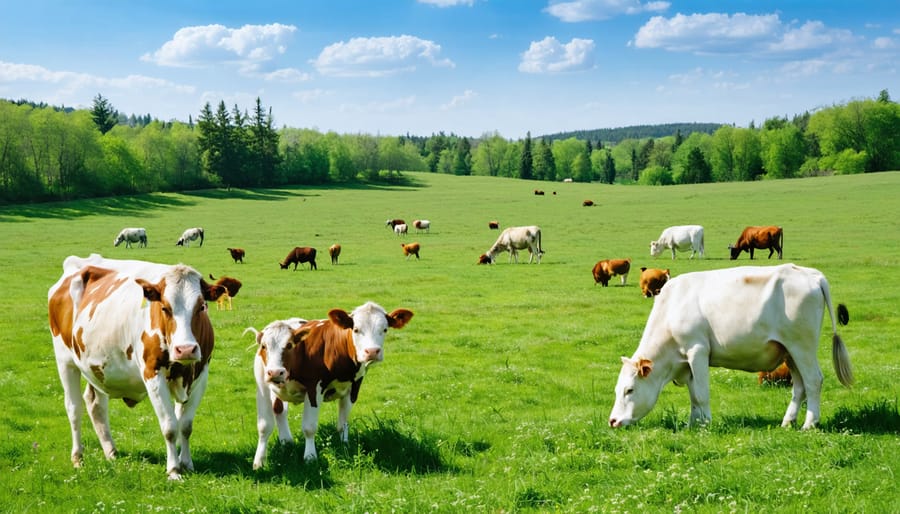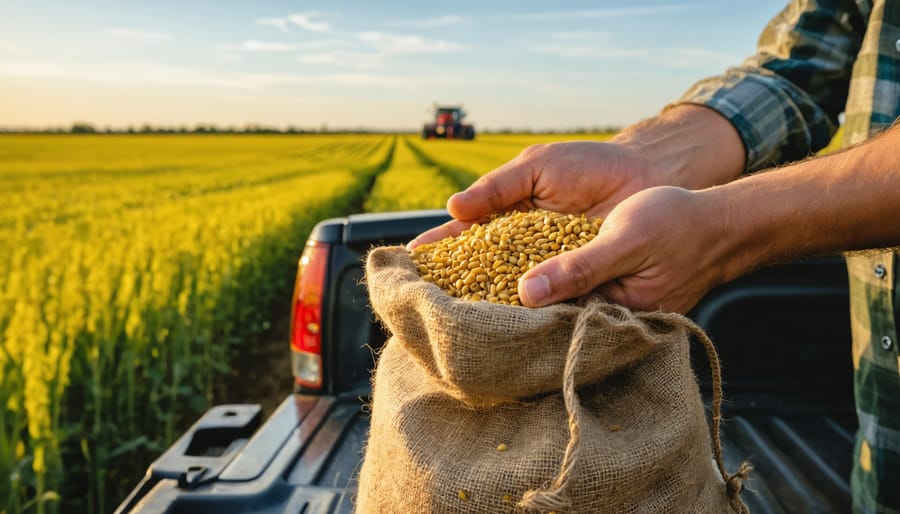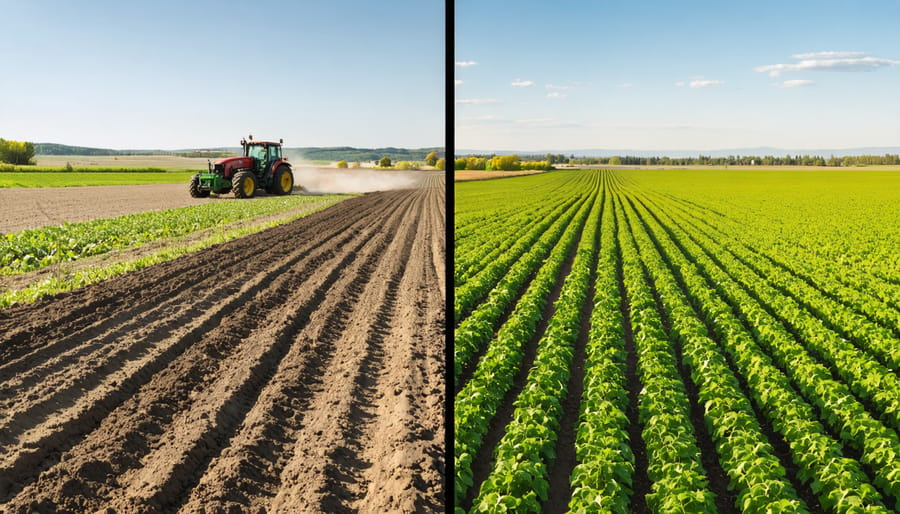Transforming conventional livestock operations into certified organic farms demands rigorous adherence to natural production methods and animal welfare standards. The organic certification process requires livestock producers to maintain detailed records of feed sourcing, veterinary care, and grazing practices while ensuring animals have continuous access to organic pasture during the grazing season.
Canadian organic livestock farmers lead North America in sustainable animal husbandry, implementing practices that prioritize natural behaviors and stress-free environments. From carefully selected heritage breeds that thrive in Alberta’s climate to innovative rotational grazing systems that regenerate soil health, organic livestock operations demonstrate that ethical farming can be both environmentally conscious and economically viable.
By focusing on preventive health measures, balanced nutrition, and proper housing conditions, organic livestock producers create resilient farming systems that meet growing consumer demand for ethically-raised meat, dairy, and eggs. This holistic approach not only ensures superior animal welfare but also contributes to biodiversity, reduces environmental impact, and strengthens local food security across the Prairie provinces.
Core Requirements for Organic Livestock Certification
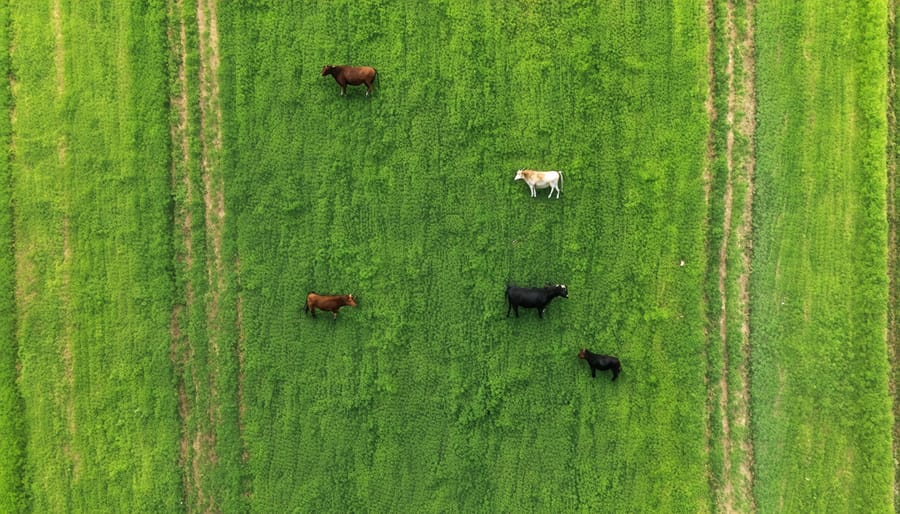
Animal Living Conditions and Welfare Standards
In organic livestock farming, animals must be provided with living conditions that support their natural behaviors and well-being. The Canadian Organic Standards outline specific safe shelter requirements that ensure proper housing and outdoor access for all livestock.
For cattle, each adult animal requires a minimum of 6 square meters of indoor space and 9 square meters of outdoor space. Dairy cows must have access to pasture during grazing season, with rest areas featuring dry bedding and natural lighting. Poultry operations must provide at least 0.5 square meters per laying hen indoors, with mandatory outdoor access of 4 square meters per bird.
All animals must have protection from extreme weather, adequate ventilation, and clean water sources. Enrichment features like scratching posts for cattle and dust-bathing areas for chickens are essential. Here in Alberta, farmers often exceed these minimum requirements, incorporating wind shelters and natural shade structures that suit our climate while promoting animal comfort.
Social interaction is prioritized, with animals housed in groups except when necessary for veterinary care or birthing. Regular monitoring ensures these standards maintain optimal animal welfare while supporting productive farming operations.
Feed and Nutrition Guidelines
Organic livestock feed must be 100% certified organic, with all grains, forages, and supplements meeting Canadian Organic Standards. Ruminants require a minimum of 30% of their diet from pasture during grazing season, which typically runs from May to October in Alberta. Fresh grass, hay, and silage should form the foundation of their nutritional intake.
When grazing isn’t feasible during winter months, stored organic forage and feed become essential. Farmers must maintain detailed records of feed sources, including harvest dates and supplier certification numbers. Mineral supplements are permitted but must be free from prohibited substances and antibiotics.
Young animals require special attention, with calves and lambs needing access to organic milk for a minimum of three months. In cases where organic feed becomes temporarily unavailable due to exceptional circumstances, farmers must obtain authorization from their certifying body before using conventional alternatives.
Supplement regulations allow for specific vitamins and minerals when documented nutritional deficiencies exist. Common approved supplements include kelp, trace mineral blocks, and vitamin A during winter months. All feed storage facilities must prevent contamination from prohibited substances and maintain clear separation between organic and non-organic feeds if both are present on the farm.
Documentation and Record-Keeping Systems
Required Records for Compliance
Maintaining accurate records is essential for organic livestock certification in Canada. Farmers must keep detailed documentation of all aspects of their operation, which should be readily available for inspection at any time.
The following records are mandatory for organic livestock operations:
Animal health records must include vaccination histories, veterinary treatments, and any medical interventions, along with dates and outcomes. Keep detailed breeding records, including breeding dates, birth records, and genealogical information to ensure compliance with organic breeding requirements.
Feed records should document all feed purchases, including organic certification numbers from suppliers, feed composition, and feeding schedules. For farm-produced feed, maintain records of field numbers, harvest dates, and storage locations.
Purchase records must detail the origin of all animals, including organic certification documentation for purchased livestock. Keep sales records of animals and animal products, including transaction dates and buyer information.
Field records should outline grazing rotations, pasture management practices, and stocking rates. Document outdoor access periods, including dates and duration of confinement due to weather or health concerns.
Here in Alberta, many farmers find success using digital record-keeping systems, though traditional paper logs are equally acceptable if properly maintained. Local organic certification bodies recommend updating records at least weekly and storing them for a minimum of five years.
Remember to document any changes in management practices, unusual events, or challenges that affect your livestock operation. This information proves invaluable during annual inspections and helps demonstrate your commitment to organic principles.
Digital Tools for Record Management
In today’s digital age, Canadian organic livestock farmers are increasingly turning to technology to streamline their record-keeping processes. Modern farm management software and mobile applications have revolutionized how we track and maintain compliance documentation. These tools have become essential for efficient digital certification management, helping farmers save time while ensuring accuracy.
Popular digital solutions include cloud-based platforms that allow real-time data entry for feed purchases, animal health records, and grazing rotations. Many Alberta farmers have found success using apps that integrate with their existing farm management systems, enabling them to upload photos of receipts, track livestock movements, and generate reports for certification inspections directly from their smartphones.
These digital tools often feature automated reminder systems for important deadlines, customizable templates for common forms, and secure storage for sensitive documentation. Some platforms even offer offline functionality, crucial for areas with limited internet connectivity.
Local agricultural extension offices provide training sessions on using these digital tools, and many certification bodies now accept electronic submissions. The transition to digital record-keeping not only reduces paper waste but also creates a more organized and accessible system for both farmers and inspectors. Remember to regularly back up your digital records and maintain both electronic and physical copies of critical documentation for added security.
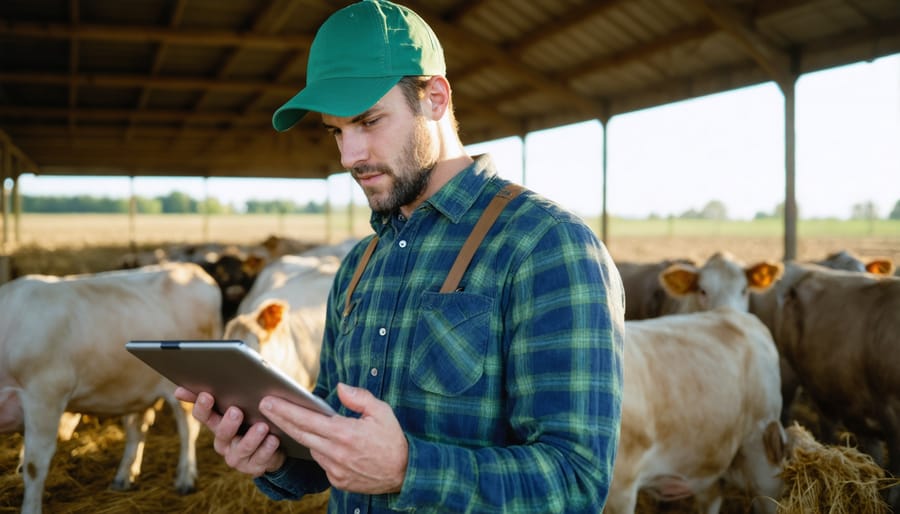
Inspection and Certification Process
Pre-Inspection Preparation
Preparing for your organic livestock certification inspection requires thorough organization and attention to detail. Start by gathering all essential documentation at least two weeks before the scheduled inspection date. Create a comprehensive file containing your livestock health records, feed purchase receipts, grazing records, and animal identification systems.
Ensure your farm maps are current, clearly showing pasture rotations, buffer zones, and facilities. Keep detailed records of purchased animals, including their organic status documentation. Maintain an organized filing system for veterinary treatments, including any allowed medications used and withdrawal periods observed.
Review your organic system plan to confirm all practices align with current standards. Prepare a list of any changes made since your last inspection or certification. Have feed samples available and ensure feed storage areas are properly labeled and organized.
Create a day-of checklist including:
– Access to all facilities and pastures
– Current inventory counts
– Processing records if applicable
– Sales receipts and transaction certificates
– Updated complaint log
– Employee training records
– Clean, organized spaces for document review
Remember to inform all key staff members about the inspection date and ensure someone knowledgeable about daily operations will be available to answer questions. A well-prepared inspection demonstrates your commitment to organic integrity and typically results in a smoother certification process.
Common Compliance Issues
Despite the strong commitment of Canadian organic livestock farmers, several common compliance challenges often arise. Feed management typically tops the list, with farmers sometimes struggling to maintain 100% organic feed sources throughout the year, particularly during harsh Alberta winters. Maintaining detailed documentation of feed purchases and ensuring proper labeling can also prove challenging.
Outdoor access requirements present another frequent hurdle, especially during extreme weather conditions. While regulations allow for temporary confinement during severe weather, determining appropriate timing and duration requires careful judgment. Some farmers have successfully addressed this by developing innovative shelter designs that provide both protection and outdoor access.
Animal healthcare documentation often causes compliance issues, particularly regarding the use of permitted treatments and maintaining proper withdrawal periods. Successful farmers recommend implementing robust record-keeping systems and developing strong relationships with veterinarians who understand organic standards.
Livestock identification and tracking can also be problematic. Many Alberta farmers have found success using digital tracking systems to maintain accurate records of animal movements and treatments. Regular staff training on compliance requirements and documentation procedures has proven essential in minimizing violations during inspections.
Remember, most compliance issues can be prevented through proactive planning and consistent record-keeping practices. Working with experienced organic certifiers and joining local organic farming networks can provide valuable support in maintaining compliance.
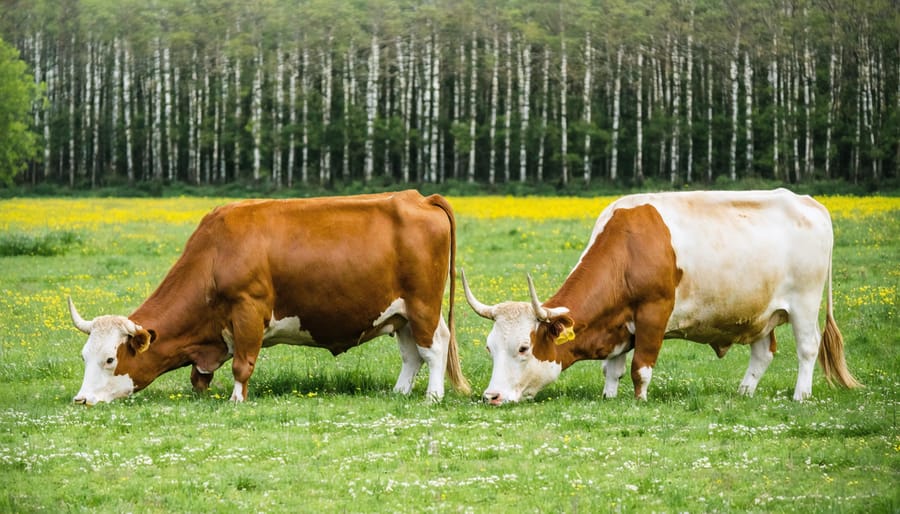
Case Study: Success on Alberta’s Organic Farms
The Thompson family farm in central Alberta stands as a shining example of successful organic livestock operations. Since transitioning to organic practices in 2012, the 640-hectare operation has become a model for sustainable cattle and poultry production, demonstrating that organic certification compliance can be both achievable and profitable.
Sarah Thompson, the second-generation farmer who spearheaded the transition, explains: “We started small, converting just 80 hectares and 50 head of cattle. This allowed us to learn and adapt without overwhelming our resources.” The farm now manages 200 head of certified organic beef cattle and 2,000 laying hens, all meeting strict organic standards.
Key to their success was the development of a robust pasture management system. The Thompsons implemented a rotational grazing program that divides their land into 20 paddocks, with cattle moving every three to four days. This approach has improved soil health, reduced parasite loads naturally, and eliminated the need for chemical interventions.
The farm’s success also stems from their innovative feed production strategy. “We dedicated 160 hectares to organic feed crops, growing a diverse mix of barley, oats, and peas,” Sarah notes. “This self-sufficiency in feed production has been crucial for maintaining our organic status and controlling costs.”
Documentation posed initial challenges, but the family developed a straightforward system using digital tools and daily logs. Their record-keeping protocol has become so effective that local organic inspectors now use it as an example for other farms transitioning to organic production.
The Thompsons have seen tangible benefits from their organic certification. Their premium organic beef commands 30-40% higher prices than conventional products, while their eggs are consistently sold out through local markets and a community-supported agriculture program.
Health improvements in their livestock have been notable. Veterinary visits have decreased by 60% since the transition, primarily due to improved living conditions and preventive health measures. The cattle show better resistance to common ailments, and egg production remains strong without artificial supplements.
Perhaps most importantly, the Thompsons actively share their knowledge with other Alberta farmers. They host bi-annual farm tours and participate in mentorship programs through local organic farming associations. “Success in organic farming comes from community support and knowledge sharing,” Sarah emphasizes. “We’re proof that with proper planning and patience, organic livestock certification is an achievable goal for Alberta farmers.”
Practical Tips for Maintaining Compliance
Maintaining organic certification requires consistent attention to detail and proper documentation. Start with a robust compliance plan development strategy that outlines your daily, weekly, and monthly tasks.
Keep detailed records of feed purchases, ensuring all suppliers provide organic certification documentation. Maintain a daily feeding log and update your animal health records promptly. Create a calendar system for tracking grazing rotations and establish clear protocols for separating organic from non-organic animals if both are present on your farm.
Regular self-audits are essential. Schedule monthly internal reviews of your documentation and operations. Use a digital record-keeping system to streamline this process and ensure easy access during inspections. Many Alberta farmers find success using smartphone apps designed specifically for organic livestock management.
Set up reminder systems for certification renewal deadlines and maintain open communication with your certifying body. Consider joining local organic farming networks to stay informed about regulatory updates and share best practices with fellow producers.
Create contingency plans for common challenges like feed shortages or animal health emergencies. Keep an updated list of approved organic veterinary treatments and their suppliers readily available. Remember to document any deviations from standard procedures, including the reasoning behind your decisions.
Transitioning to organic livestock farming represents a significant but rewarding journey for Alberta farmers. Throughout this guide, we’ve explored the essential components of successful organic livestock operations, from certification requirements to daily management practices. The key to success lies in maintaining detailed records, implementing robust animal welfare practices, and following organic feed protocols.
As you move forward with your organic farming journey, remember that the local farming community and agricultural extension services are valuable resources. Start by developing a comprehensive transition plan, connecting with experienced organic farmers in your area, and gradually implementing changes to your operation. Consider joining organic farming associations in Alberta to stay updated on best practices and networking opportunities.
The growing demand for organic livestock products in Canada presents an exciting opportunity for farmers willing to make the transition. While the initial certification process may seem daunting, the long-term benefits of improved soil health, animal welfare, and market premiums make it a worthwhile investment. Take the first step by contacting local certification bodies and developing your organic system plan. Remember, sustainable agriculture is not just about following regulations – it’s about building a resilient farming future for generations to come.

